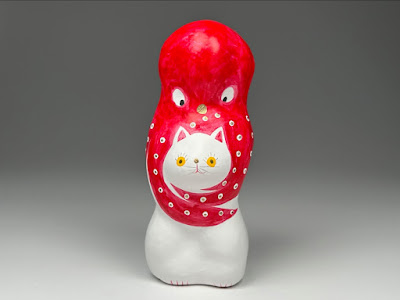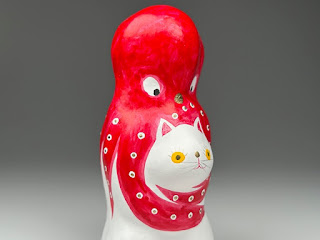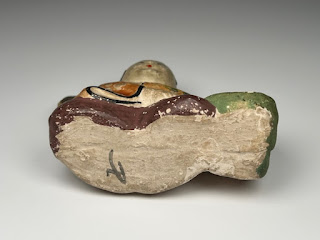新旧の相良人形 New and Old Sagara Clay Dolls
猫に蛸 Cat and Octopus
蛸が頭にからみついているこの猫ちゃんは、相良人形の当代(八代目)、相良隆馬氏の作品。蛸は多幸に通ずる縁起物で、東北あたりでは年取り(大晦日の夜)の膳には酢だこが欠かせないほどだ。この土人形は10年くらい前に週刊文春の表紙に採用されるなど(可児弘明、タコペディア にっぽん、2012年)、そのユニークな取り合わせから猫好き(蛸好き?)の人々の人気を得て、いまや入手困難なレア品にまでなっている。人形の型自体は昔から相良家に伝わっているものらしいが、八代目の独特の絵付けが現代に受け入れられているのだろう。
This unique combination of a cat and an octopus has been known in old Sagara dolls. In Japan, octopus is thought to bring good fortune, and people in the Tohoku region eat pickled octopus on New Year's Eve. In the past ten years, the contemporary and cute painting by Sagara Ryuma (the 8th master of the Sagara doll studio) has received widespread acclaim, bringing further renown to the the Sagara doll.
お囃子 A Drummer
ここから紹介する土人形は江戸後期から明治初頭頃の古人形で、相良人形かどうかの確証はない。陶磁器や漆器など他の工芸品もそうだが、当時の職人は作品に銘を入れるなどということはまずなく、今となってはそれがどこの誰がつくったものなのか不明なことが多い。ただしある種のトレードマークのようなものは存在し、この土人形の場合、お顔立ちもさることながら、着物に描かれている五弁の花紋様は相良人形に独特のものだ。これは桜の花びらをデザイン化したもので、とくに全体が白色で、花びらがハート型になっているものは、おとなり宮城の堤人形に類例が多少みられるものの、これがあればほぼ相良人形と断定できるくらいの目印になっている(たとえば菊地和博「梅津コレクションにみる相良人形の形態的分析」山形県立博物館研究報告、1989年)。
This and the next ones are vintage dolls created about 150 years ago. Due to the lack of a manufacturer's signature on such old dolls, it is generally difficult to say where and by whom they were made. However, this doll is very likely to be a Sagara doll because there is a five-petal flower (sakura) mark on the drummer's sleeve. In particular, the white heart-shaped petal is only seen in the Sagara doll.
本来3次元的な人物の動きを平面的に表現しているが、それでいてばちを振り下ろすさまには躍動感がある。裃を着ていることからなにか改まった場面、たとえば神楽とか歌舞伎のお囃子のように思える。かつて米沢あたりではこうした素朴な土人形をひな祭りの時期に飾って子どもの成長を祈った。今でいうひな人形の五人囃子の原型かもしれない。古人形にしては状態がよく、金泥や蘇芳・黄肌などの顔料の剥離がすくないのがうれしい。
The three-dimensional drummer's movement is well expressed as rather two-dimensional relief-like clay statue. The boy's formal clothes indicate he was a musician of a religious or kabuki dance. In the past, people in Yonezawa where the Sagara dolls were popular displayed clay dolls like this at home in March, hoping children's healthy growth. It is nice that gold, suo and kihada red, and malachite green are well preserved.
布袋子抱き A Potbelly Buddhist (Hotei) with a Child
布袋さまとおもわれるふくよかで袋を携えた僧侶風の人物が子どもを抱きかかえている。白隠の禅画にも通ずるあたたかみを感じる。人物の目の描き方は俗に「三角目(三角眼)」と呼ばれ、これも相良人形のトレードマークのようなものだ(こちらの記事を参照)。ただこの人形の三角目は描き方がやや雑だ。あまり考えたくないが後代のだれかが目を描きなおしたのかとの疑念さえ抱く。ただ逆にそれがちょっとおどけた表情をつくりだして、人形の魅力を高めているとも言える。
Hotei, a legendary Chinese buddhist, has been a popular motif in Japanese paintings and statues. I think this Hotei doll embodies a Zen painting of Hakuin Ekaku. The "triangular" eyes are characteristic of the Sagara doll. Though this doll's eyes are a little simplified, they are rather suitable for the motif of good relationship between Hotei and a child.
日本郷土人形研究会編「寺沢人形」(郷土人形図譜 15号、2004年)に掲載の「子負い袋曳き童子」と同型とおもわれ、色づかい、筆づかいも似ているので、寺沢人形(幕末期に、相良家と親戚筋にあたる寺沢家が、相良人形の材料や技術の供与を受けてつくったと現代の人形愛好家が推定している製品)かもしれない。同書によるともともと布袋さまだけの構成だったものを、型に細工して子どもを付け足した節があるという。寺沢人形については以前の記事も参照。
According to a reference book, this might be a Terasawa clay doll, which serious doll collectors suppose that Terasawa family, a relative to Sagara family living in the neighborhood, created in the mid 19th century with the help of Sagara family. See a previous post about the Terasawa doll.











